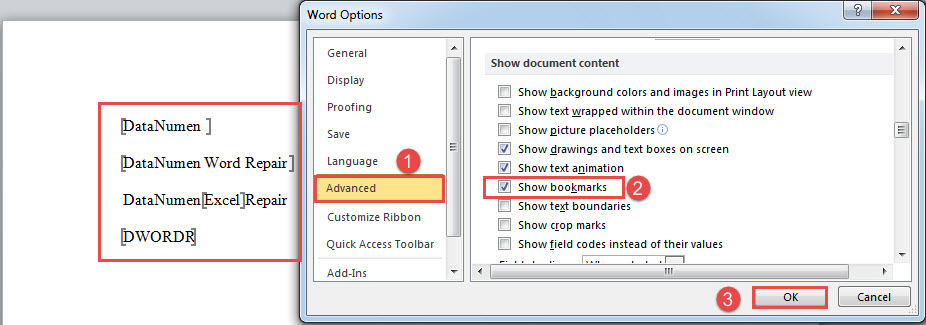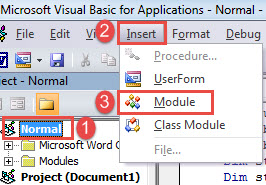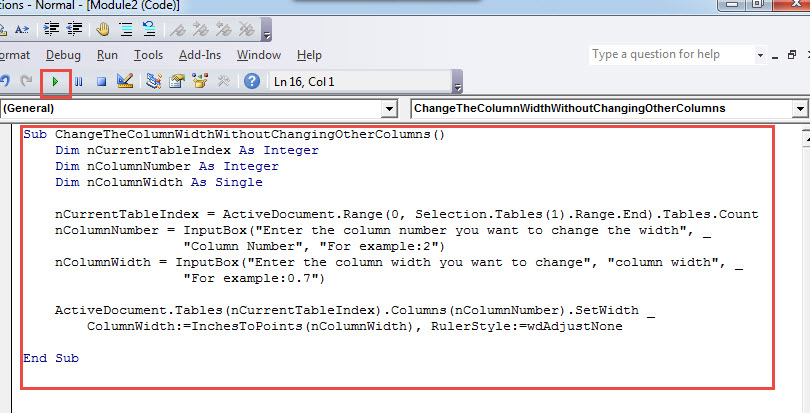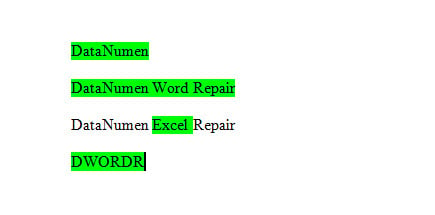In this article, we would like to provide you with 2 smart ways to show all bookmarks in your Word document.
Every once in a while, we insert bookmark for a selection of text that we want to revisit later. But the nature of bookmark in Word makes it uneasy to identify. In another word, we can’t view bookmarks directly without toggling some options in Word. 
This article is devoted to helping you see bookmarks in a clear way. You can pick either way to practice.
Method 1: Show Bookmark Brackets
- First and foremost, click “File” tab in the Ribbon.
- Then click “Options” to open the “Word Options” dialog box.
- Next click “Advanced” in the left column.
- Scroll down to “Show document content” section and check “Show bookmarks” box.
- Finally, click “OK” to save the modification.
Now there are square brackets around bookmarked items. You can see these brackets are in grey color which is not so evident sometimes. And you may confuse them with normal square brackets.
Therefore, we want to recommend you a macro to highlight bookmarks as to stand them out in a better way.
Method 2: Highlight Multiple Bookmarks
- To begin with, press “Alt+ F11” to invoke VBA editor.
- Next click “Normal” project.
- Then click “Insert” tab on menu bar and choose “Module” on drop-down menu.
- And double click on new module to open its editing space on the right side.
- Paste following macro there:
Sub HighlightBookmarkedItemsInADoc()
Dim objBookmark As Bookmark
Dim objDoc As Document
Application.ScreenUpdating = False
Set objDoc = ActiveDocument
With objDoc
For Each objBookmark In .Bookmarks
objBookmark.Range.HighlightColorIndex = wdBrightGreen
Next objBookmark
End With
Application.ScreenUpdating = True
End Sub
- Last but not the least, click “Run” or hit “F5”.
Next thing you see is all bookmarks are highlighted in green, such as below:
Above macro highlight all bookmarks in current active document. In case, there are several documents to process, you then need this macro instead:
Sub HighlightBookmarkedItemsInMultiDoc()
Dim StrFolder As String
Dim strFile As String
Dim objDoc As Document
Dim dlgFile As FileDialog
Set dlgFile = Application.FileDialog(msoFileDialogFolderPicker)
With dlgFile
If .Show = -1 Then
StrFolder = .SelectedItems(1) & "\"
Else
MsgBox "You need to select a folder first!"
Exit Sub
End If
End With
strFile = Dir(StrFolder & "*.docx", vbNormal)
While strFile <> ""
Set objDoc = Documents.Open(FileName:=StrFolder & strFile)
Set objDoc = ActiveDocument
With objDoc
For Each objBookmark In .Bookmarks
objBookmark.Range.HighlightColorIndex = wdBrightGreen
Next objBookmark
End With
objDoc.Save
objDoc.Close
strFile = Dir()
Wend
End Sub
Before running this macro, you have to put all target documents in the same folder. And running the macro shall trigger “Browse” window. Just pick the folder you store your documents.
Utility to Repair Documents
If you run into Word damage, there is high possibility that it might wipe out some critical information from your computer. It can be no big deal if you have a latest backup to refer. However, if not, you will need a repair tool immediately.
Author Introduction:
Vera Chen is a data recovery expert in DataNumen, Inc., which is the world leader in data recovery technologies, including repair xlsx and pdf repair software products. For more information visit www.datanumen.com



